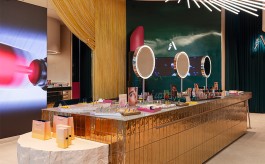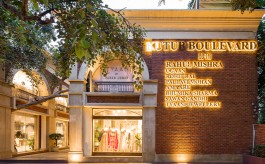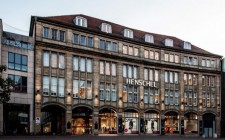Carlo Pazolini's new UK store is an ode to history
By Susmita Das | Vjmedia Works | 3 | September 04, 2013
Carlo Pazolini, the new innovation by Giorgio Borruso Design, recreates the old charm of the historical Brompton Arcade
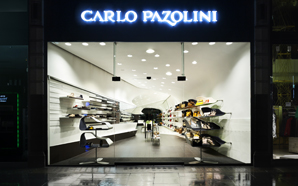 Carlo Pazolini, positioned at Brompton Road in the UK, is a 120 sqm space in Knightsbridge, housing men's and women's shoes and accessories. The design marks an evolution of the Carlo Pazolini worldwide store concept integrating specificities of site.
Carlo Pazolini, positioned at Brompton Road in the UK, is a 120 sqm space in Knightsbridge, housing men's and women's shoes and accessories. The design marks an evolution of the Carlo Pazolini worldwide store concept integrating specificities of site. Designed by the Los Angeles based Giorgio Borruso Design firm, this newly created store leaves the impression of the historical Brompton Arcade. "While exploring the history of the area and the building, from the early 1900's, it was discovered in planning archives that the neighboring historical Brompton Arcade was converted into a retail space in the last decade, installing a new roof structure and remodeled mezzanine. So, our design sought to recognize the memory of this arcade by recreating a contemporary barrel or tunnel vault ceiling as well as the illusion via a mirror wall that the space opens to the exterior at the back,†explains Giorgio Borruso
A historical detail in the facade has been used in conjunction with the seating and wall shelving as a generative seed for the interior geometric language leading to a pointed barrel vault design. The memorialization of this neighboring arcade space led to a tunnel-like twisting of the interior in such a way that the floor, walls, and ceiling became wrapped into one another, creating a vortex of movement from front to back in which design elements flock like school of fish moving through a turbulent fluid environment.
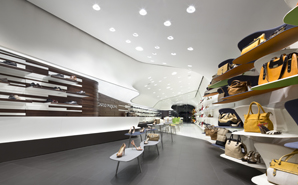 The design of the interior programmatic elements for this shoe store which includes the seating, display, storage, and point of sale recognizes that there is an ambiguous distinction between our bodies and the things we wear. On this note, Giorgio explains, "Like the buildings we inhabit, we shape our clothing and it shapes us. Attempts at accurately sculpting the shape of the human foot in Egyptian, Classical, and contemporary art imply that footwear literally shapes our feet over time.â€
The design of the interior programmatic elements for this shoe store which includes the seating, display, storage, and point of sale recognizes that there is an ambiguous distinction between our bodies and the things we wear. On this note, Giorgio explains, "Like the buildings we inhabit, we shape our clothing and it shapes us. Attempts at accurately sculpting the shape of the human foot in Egyptian, Classical, and contemporary art imply that footwear literally shapes our feet over time.†He further adds, "Artists in the 19th Century who wanted to recreate Classical styles complained that the feet of contemporary shoe-wearing models had to be abstracted to more closely match the feet in a sandal-wearing Greek or Roman culture. The feet contain 1/4 of the body's bones- each one part of a flexible adaptive network, each node offering the potential for that network to be subtly reshaped. As newborns, our toes quickly take on the shape of the shoes we wear, but for a brief time are remarkably dexterous, like plaster ready to be cast by muscle memory. This is the nature of the space we sought to create, and with that in mind, used the shape of an infant's foot as a Platonic or iconic "cell" in an emergent network of display shelving and seating.†To further refine this concept, the design group has looked onto the principle of Swarm Intelligence which digitally abstracts phenomena in the natural world like insect swarms, school of fish and flocks of birds. These natural examples of swarm intelligence form loose cellular networks that negotiate an ephemeral distinction between object and space.
The synthesis of old and new, of the biological with culture and technology, is reinforced by material innovations that bring together new structural resins with one of the most ancient materials, the natural wool felt. The shelving and seating cells in this project have used an innovative molding process which without glue bonds the natural wool and the resin at a molecular level, forming a new structural composite that synthesizes old and new, natural and technological.
Advertisement

